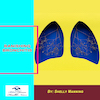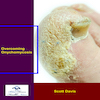 A fungal infection of the toenails or fingernails might seem like a small nuisance.
A fungal infection of the toenails or fingernails might seem like a small nuisance.
But new research in Diabetes & Metabolic Syndrome: Clinical Research & Reviews reveals it could be a serious warning sign of something much more serious… type 2 diabetes.
Doctors have long known that people with diabetes are more prone to nail fungus.
It made sense: diabetes weakens the immune system and reduces blood flow, making it harder to fight fungal infections.
But researchers in Israel flipped the question:
What if nail fungus isn’t just a result of diabetes—but a warning that it’s on the way?
They followed 112,000+ adults insured by Israel’s largest health organization from 2000 to 2022. Everyone started out diabetes-free.
During the study, they recorded:
-
● 68,201 cases of nail fungus
● New diabetes diagnoses
● What treatments were received
● Other medical conditions, age, sex, and lifestyle factors
Here’s what they found:
-
● People with nail fungus had 2.21x higher risk of developing type 2 diabetes
● The more often nail fungus occurred, the higher the risk
● People who treated the infection had lower diabetes risk than those who didn’t
These results held up even after adjusting for age, other conditions, and demographics.
What does this mean?
If your nails are thickened, yellow, or crumbly—and especially if it keeps coming back—don’t ignore it. It could be your body’s early cry for help, long before your blood sugar spikes into danger territory.
But treating nail fungus traditionally is very ineffective. Creams and pills generally don’t work.
Our approach is different. It attacks the fungus from both inside and out. That’s why it works for almost everyone. Plus, it’s 100% natural and requires no supplements or creams. Learn more here…
But if you already suffer type 2 diabetes, getting rid of nail fungus isn’t enough. Thousands of readers have completely reversed their diabetes using a few simple diet changes—explained here…

 Overcoming IBD
Overcoming IBD Multiple Sclerosis
Multiple Sclerosis Banishing Bronchitis
Banishing Bronchitis Gum Disease Gone
Gum Disease Gone Overcoming Onychomycosis
Overcoming Onychomycosis Neuropathy No More
Neuropathy No More The Prostate Protocol
The Prostate Protocol Brain Booster
Brain Booster
 Ironbound
Ironbound
 Solution for Shingles
Solution for Shingles
 The Bone Density Solution
The Bone Density Solution
 The Ultimate Healing Protocol
The Ultimate Healing Protocol
 The Parkinson's Protocol
The Parkinson's Protocol
 The Chronic Kidney Disease Solution
The Chronic Kidney Disease Solution
 Overthrowing Anxiety
Overthrowing Anxiety The Fatty Liver Solution
The Fatty Liver Solution The Hypothyroidism Solution
The Hypothyroidism Solution
 The End of Gout
The End of Gout The Blood Pressure Program
The Blood Pressure Program
 The Oxigized Cholesterol Strategy
The Oxigized Cholesterol Strategy
 Stop Snoring And Sleep Apnea Program
Stop Snoring And Sleep Apnea Program
 The Arthritis Strategy
The Arthritis Strategy The Vertigo & Dizziness Program
The Vertigo & Dizziness Program The 3-Step Diabetes Strategy
The 3-Step Diabetes Strategy Hemorrhoids Healing Protocol
Hemorrhoids Healing Protocol The Erectile Dysfunction Master
The Erectile Dysfunction Master Weight Loss Breeze
Weight Loss Breeze The IBS Program
The IBS Program The Insomnia Program
The Insomnia Program The Migraine and Headache Program
The Migraine and Headache Program The Neck Pain Solution
The Neck Pain Solution The Menopause Solution
The Menopause Solution The Ejaculation Master
The Ejaculation Master The TMJ Solution
The TMJ Solution The Acid Reflux Solution
The Acid Reflux Solution The Fibromyalgia Solution
The Fibromyalgia Solution The Psoriasis Strategy
The Psoriasis Strategy